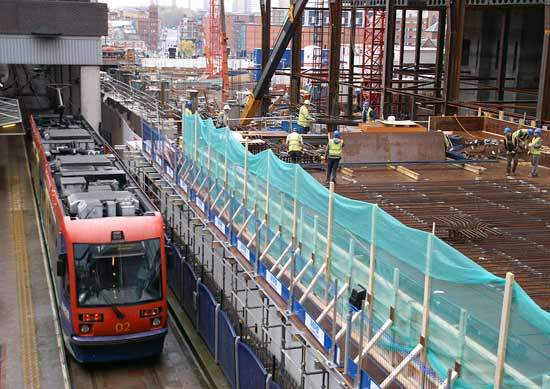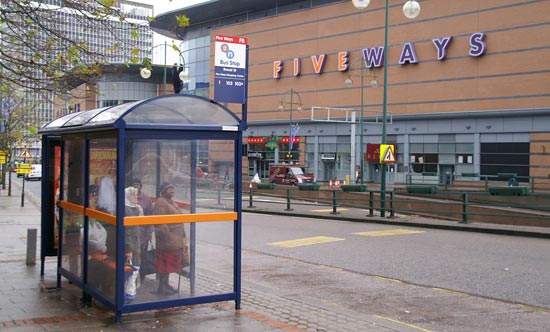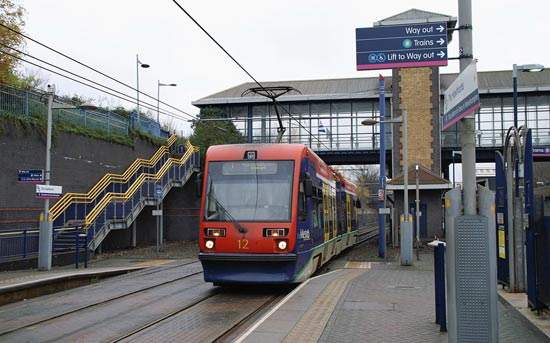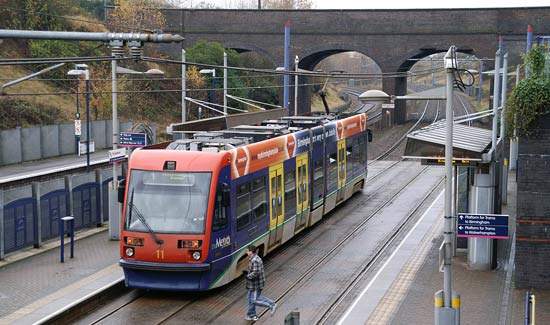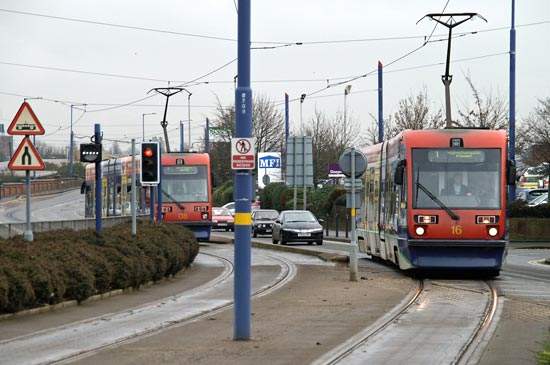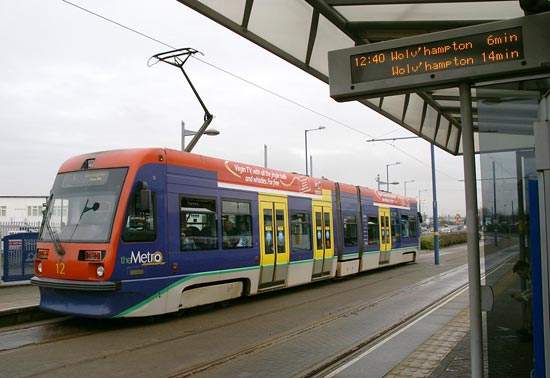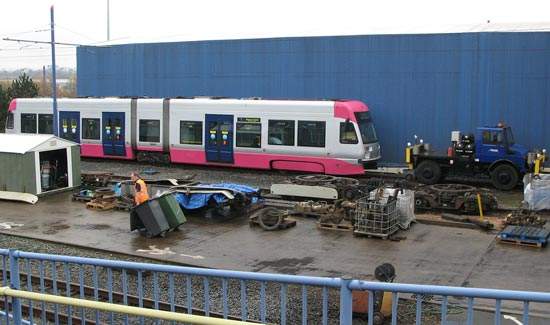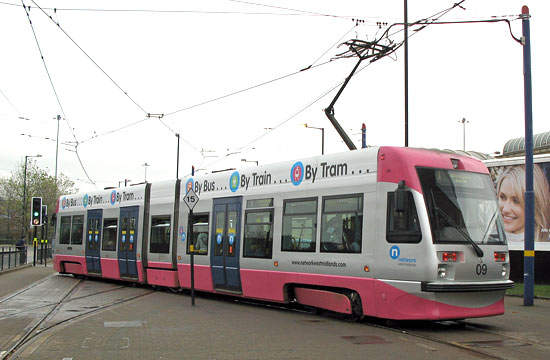The 12.7 mile (20.1km) Midland Metro light rail system links the UK’s second largest city, Birmingham, with Wolverhampton to the north-west, the two also connected by a heavy rail main line.
Part of the biggest UK commuter market outside London, the Metro opened in 1999 after protracted delays caused by difficulties in accepting the Ansaldo-built trams, as well as infrastructure issues.
Originally envisaged as a network of routes, cost concerns and high-level political resistance have led to Line 1 remaining the only line.
Although lower than projected, passenger loadings are steadily rising and by 2007 there was renewed optimism that the Metro would break from its present confines.
The project
The successful bid to build, operate and maintain the system was made by an Anglo-Italian consortium of vehicle builder Ansaldo Trasporti and civil engineer Taylor Woodrow, the latter replaced by John Laing Construction, operating together under the Altram name. They were awarded a 23-year concession (three years for construction and 20 years’ operation) in August 1995, with construction beginning three months later.
In 1996 Travel West Midlands joined the consortium, and in March 2006 Altram became wholly part of the National Express Group plc, also principal operators of the area’s large bus network.
The total system cost was £144.8m, of which central government grants and loans accounted for £80m, with £31m coming from the European Regional Development Fund. The West Midlands Passenger Transport Authority, the region’s statutory local transport provider, provided £17.1m, while Altram contributed £11.4m.
In March 2010, the UK Department of Transport approved the £127.1m Midland Metro extension project. The UK Government will fund about £81m of the total estimated cost of the project.
The extension will connect the Metro Line One to Birmingham New Street Station and will replace the existing tram carriages of the metro system. In addition, the maintenance depot of the system will also be refurbished.
Construction work is expected to begin in 2012 and scheduled to be completed by 2014.
Infrastructure
The Line 1 route is basically the same as the former Great Western Railway main line (closed in 1972) between Birmingham Snow Hill and Wolverhampton. Much of the region’s former heavy manufacturing industry has closed, and the Metro provides a vital transport link for disadvantaged areas, with its presence encouraging nearby modern housing developments.
The system suffered severe problems with vandalism, including repeated theft of overhead wiring during the construction. Security improvements include CCTV coverage and the introduction of on-board conductors. Four park and ride sites are adjacent to Metro stops.
From Birmingham Snow Hill, where it occupies one of four platforms, to the Hawthorns stop, Metro runs alongside and shares some station sites with the heavy rail route reinstated in 1995.
The Metro follows the main GWR alignment with a mix of new stops and redeveloped heavy rail stations until the outskirts of Wolverhampton, where for 2km it enters the city along the A41, the only section of street running.
The northern terminus is on-street at Wolverhampton St George’s, not reaching the city centre proper, also distant from bus and rail stations.
The depot and administrative base is the Metro Centre, alongside the Wednesbury Great Western Street stop, with tram access and a test track from near the Wednesbury Parkway stop.
Rolling stock
The Metro fleet is 16 Type T69 trams, a two-car layout with a short central articulated section. They were built at Caserta, Italy by Firema / Ansaldo Transporti. The company was also contracted for signalling and communications equipment, power supply and overhead equipment.
Although availability has increased over earlier poor performance, lack of flexibility within the small fleet has encouraged the likelihood of complete replacement when the system expands. First deliveries were in 1998, and units were commissioned and tested on the Metro Centre test track.
Featuring low-floor access, each six-axle tram has 56 seats, can carry up to 208 passengers, is fully accessible for disabled people and has two wheelchair spaces. They have a maximum speed of 70km/hr (43.5mph), and can stop in 182m. End-to-end journey time is 35 minutes.
Of the 16 trams, which cannot operate in multiple, 13 are required to operate the seven-minute interval service during most of the day, or ten minutes for evenings and Sundays.
Communications
The system is controlled from the Metro Centre. Trams are equipped with automatic train control system, passenger displays, CCTV with live display and public address. Stops have intercom connection with Metro Centre, and in October 2007 a £250,000 replacement programme of digital displays with real-time information was completed.
Through-ticketing with Travel West Midlands buses applies on some routes and multi-mode area travel passes that include the Metro are available, promoted by Centro (corporate identity of the West Midlands Passenger Transport Executive).
The future
From 2007, the Metro began a transition in identity to that of Network West Midlands, a partnership between Centro and West Midlands bus, rail and tram operators. To encourage further public transport use, the various modes are being promoted more cohesively. Stops and trams are being re-liveried with a common styling that cross-promotes heavy rail and bus.
Encouraging though this is, a healthy future for trams in the West Midlands is only likely to result from breaking out of its current confines.
Plans include ambitious extensions, such as the 14km from the city centre to Birmingham International Airport, 7.5km to Quinton and 10km to Great Barr. The 5W’s route (Wolverhampton to Wednesbury via Wednesfield, Willenhall and Walsall) would include a loop around central Wolverhampton that would bring a much-needed connection between the Metro and the city’s busy bus and railway stations, although such a loop could exist as a free-standing project.
South from Line 1 at Wednesbury and largely using disused heavy rail routes, an 11.7km extension would go to Brierley Hill, Dudley, and include the large Merry Hill shopping complex.
The £500m Ballymore property redevelopment around Birmingham Snow Hill includes basic infrastructure started in spring 2007 to bring Metro onto the city streets with a key £116m, 3.2km extension that will give greatly raise awareness of the Metro. From a new junction between St Paul’s and Snow Hill, it will pass the main rail hub at New Street, going on to the Five Ways intersection and Edgbaston via Broad Street.

